I can't remember the first time I did it. What comes to mind is the wonderful
sensuousness I felt, it was everything I thought it would be. Actually it was
more. I didn't realize I would like it so much and would develop a powerful
craving that will surely follow me to the grave.
Oh, I'm not talking about that first time! Of course I remember the first time
I did that. It happened on the front seat of my secondhand black Plymouth,
Wednesday evening, June 19, 19--well, just a few weeks ago, it seems. No, I'm
talking about the first time I ate a French oyster. Maybe it happened on my
first trip to France--yes, now I remember. That would put it exactly ten years
after I had the other first time. So I can celebrate a double anniversary this
year--my 35th and 45th.
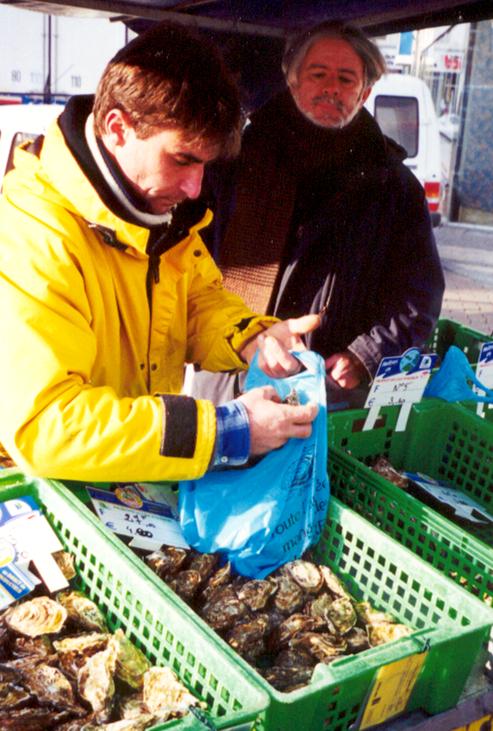 |
Thierry Sorlut, 35, (left) is teaching me to be an oysterman.
His great-grandfather started the family business.
|
If it's true that oysters are an aphrodisiac, as many people think, I
would be in detention right now, because during the winter I eat dozens
upon dozens.
I get them from my friend, Thierry Sorlut, who drives five hours from
the Atlantic coast every weekend and sets up his stand in a nearby town,
bringing a truckload of oysters just plucked from the water the day before.
But this is not a story of an aphrodisiac, it's about a delicious act
of cannibalism, for the oyster is the only animal eaten alive by human
animals around the world.
And this is where a guy like Thierry Sorlut comes in. The French are strict
about insuring that their oysters are safe. But if you buy at a big supermarket,
especially during the hectic market period of Christmas/New Year's, when 40
percent of the year's oysters are sold, you may wind up with little animals
that are about to exhaust their life cycle. If stored properly, an oyster can
live around 17 days after being removed from the water. But who wants that?
That's why I like to know my oysterman. This is something I picked up from
my wife Claude. Like every good French cook, she makes it a point of getting
to know her butcher and fish vender. If you put the relationship on a friendly
personal basis, you'll have more confidence in what you are eating and often
wind up with something better than a faceless customer gets. She certainly does.
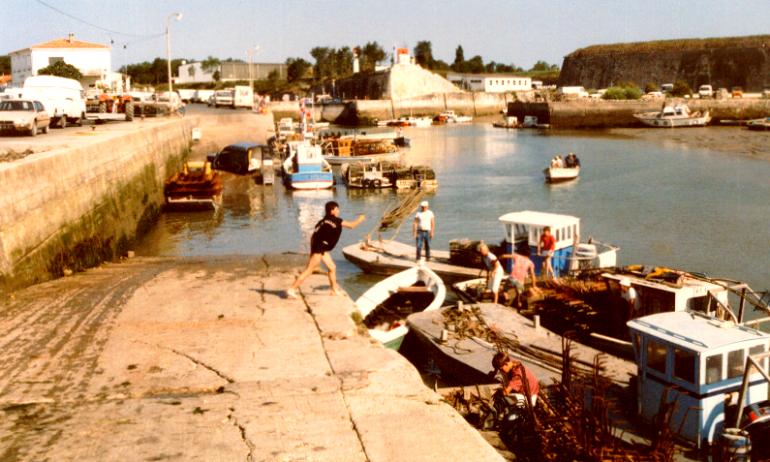
Thierry Sorlut tossing a net to his dad before hopping aboard
their boat to begin a day's hard work as an oysterman. |
Thierry's village is on the island of Oléron, just off the Atlantic
coast. Oléron is the number one oyster producer in France. Number two
is the Bay of Arcachon, not far from Bordeaux, which happens to be where we
vacation every summer. There was an old formula that you could only eat oysters
during months which contain the letter "r," effectively putting May,
June, July and August off limits. But that has changed and now they can be eaten
year round. Cultivators have learned to manipulate the reproduction cycle. Some
even practice sterilization by genetic modification, although my summer oysterwoman
tells me that the technique is forbidden on the Bay of Arcachon, where producers
make much of their money selling freshly hatched oysters to other cultivators
around the country.
The oyster has sex only with itself, it's hermaphroditic. (Not only are you
eating a live animal but also a hermaphrodite!) Actually, an oyster is essentially
a water filtration machine. It has no brain or propulsion capability. It can
sift about two gallons of water (8 liters) an hour looking for nutrients such
as plankton. And here is the key point to oyster cultivation. It can also absorb
pollutants, and toxic metals like mercury, lead, and cadmium are especially
dangerous. But professional cultivators like Thierry Sorlut are acutely aware
of the danger and they are constantly testing the water to make sure it is pollutant-free.
I had a fantasy about becoming an oyster cultivator, until Thierry started
telling me what is involved. It's hard physical labor, dawn to dusk work. For
this reason, a lot of the younger members of oyster-raising families are fleeing
to the cities and finding jobs that involve trolling a computer.
The first step begins with the newborn oyster, which is just a speck. The Romans,
who began cultivating oysters two thousand years ago, noted that newborn oysters
attach themselves to some object in order to grow. So a support system for their
growth is the main element of the oysterman's parc, which in this case
means oyster bed or enclosure. Depending on the region, the support system is
made of iron rods, tiles, or plastic tubes. It doesn't much matter. Oysters
will attach themselves to an old rusty bike tossed into the sea.
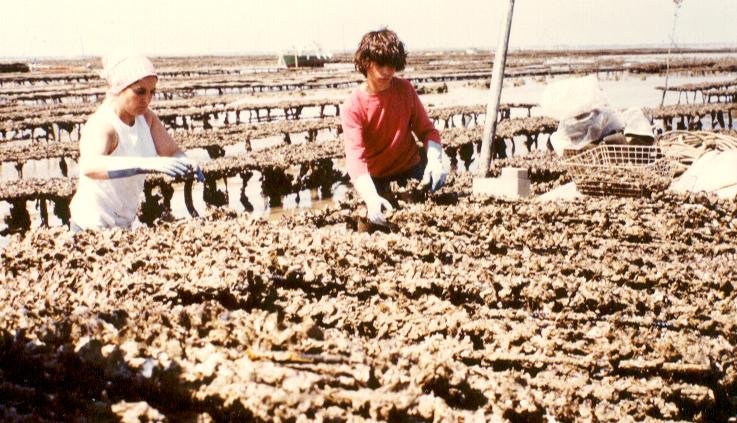
Oysters grow for 18 months on a support system and often
stick together. Now they are separated and prepared for the second step.
That's Thierry at a younger age helping his mom. |
After the oysters are taken from the support system and sorted by size, they
are placed once again on tables in the water for another few months or a year.
An oyster is ready for the market between two and three years of age. The next
to last step is called affinage, which means "refining" the
oysters in an enclosed basin, which gives them a good taste. The final step
is the purification process, which takes place in an artificial basin. The oysters
must stay in this strictly controlled clean water for a minimum of 24 hours.
That is when Thierry plucks them from the water and brings them to our market.
The oysters are sorted by size and age and given a number. I like the number
1 or 2's, which are on the fat side.
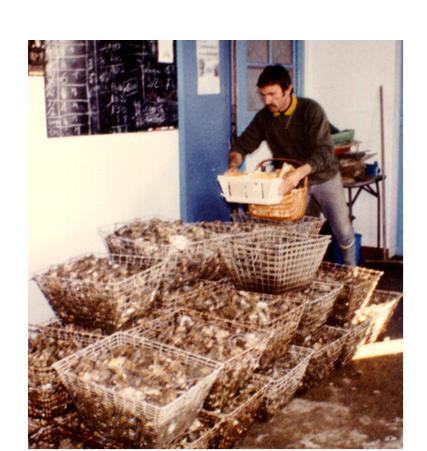
Oyster cultivation involves a lot of heavy lifting. This is Thierry's father. |
Now that Thierry has brought us fresh, tasty oysters, some of the best
in France, all we've got to do is flip them open in two seconds and enjoy
them, right?
Unfortunately, it is not that easy.
Opening oysters is a craft that demands practice. At my first New Year's
Eve celebration after we moved from Spain to France, I was charged with
preparing over 200 oysters for the party.
Claude and her friend Annie kept darting into the kitchen to tell me
what a lousy job I was doing. Finally, after hearing my job report six
times, I said, "It's obvious that you two know more about this than
I do, so please be my guests."
I poured myself a glass of white wine and walked out of the kitchen,
leaving them with 18 dozen oysters to open. That was the last criticism
I heard about my skills with an oyster knife.
Actually, I was doing a lousy job. When I wasn't stabbing myself,
I was leaving enough broken shell mixed with the oyster to provide the
partygoer with a calcium supplement enough for a month.
I'm opening oysters at our vacation place on the Bay of Arcachon.
This is a trick my friend Pierre Muller taught me. He has got a little
plastic box, looks like a soap container, and you put the oyster inside,
pull the top down, then insert the knife in the side where the valve muscle
is located, and twist upward. You don't risk stabbing yourself. I eat
oysters in July and August too--neither one an "r" month.
|
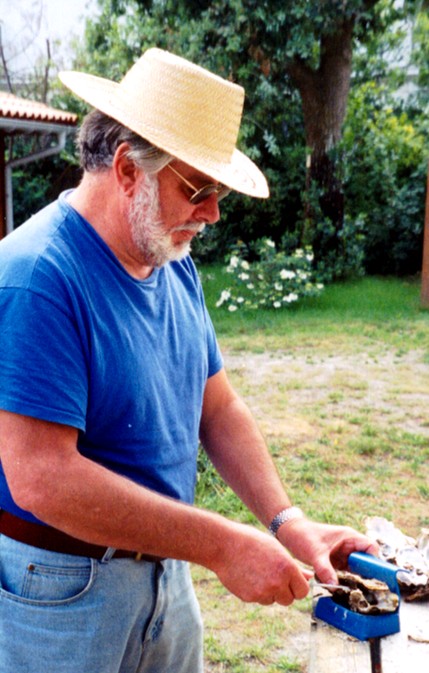 |
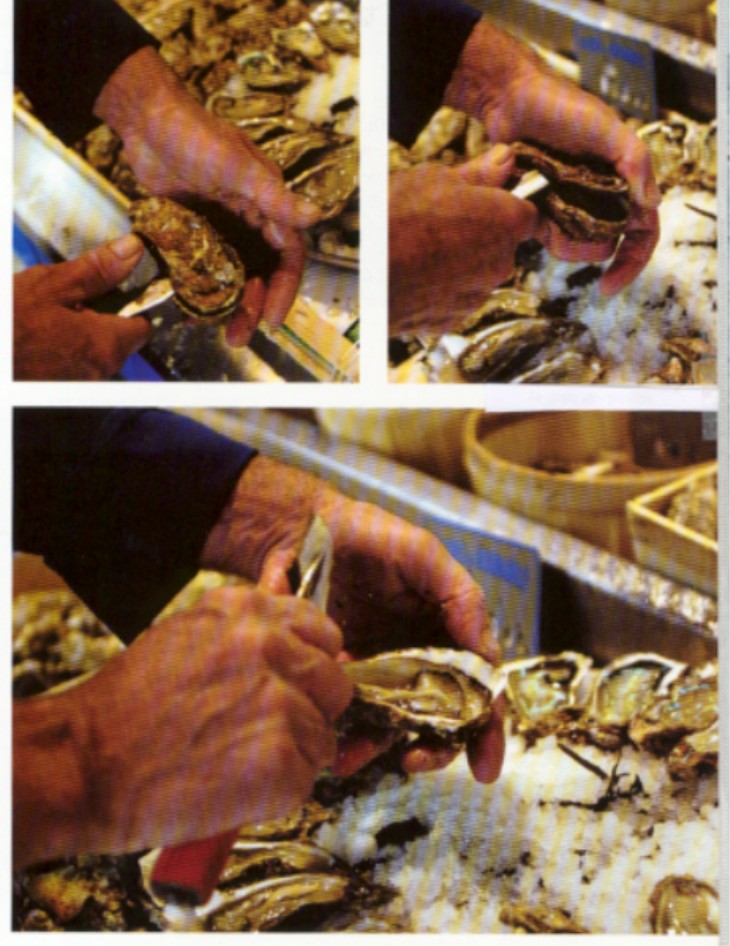 |
| Oysters are divided into two parts--the top, which is flat, and the
bottom, which is curved. The two parts are held together by a muscle. Insert
the blade into the side where the muscle is located and cut it. Here is the
way the professionals do it. Hold the oyster with the flat part up and the widest
end pointing forward. That puts you into the position to cut the muscle by inserting
the blade, moving it back and forth, and twisting up to remove the top. Don't
try this without a glove or other protection. I'm pretty good at it now, but
every time I get a little over confident and forego the protection, I wind up
punching a hole in my hand. |
My favorite way to eat oysters is by opening them one by one, leaning over
the kitchen sink, at 7:30 in the morning. I leave the oysters covered overnight
on the outside sill of the kitchen window and they are nice and cool. This of
course is not an ideal hour for drinking white wine with the oysters, and once
when Claude saw me clearing my palate afterward with a gulp of Diet Pepsi, she
practically screamed: "You barbarian!" "Chaque américain
son goût," I replied.
If you are on a trip to France and not very familiar with oysters, you might
not want to go to the trouble of preparing them yourself. I suggest that you
find a good Paris bistro that has a seafood stand outside. These stands are
manned by écaillers, professionals who prepare seafood platters
for the bistro, shivering in the cold. You can fully trust them.
And don't forget, when you eat your first oyster in France, write down the
date. Then, unlike me, you will always be able to remember this first time,
too.
The Foie Gras Imperative
Oysters are one of two special treats most often found on French tables at
Christmas and New Year celebrations. But not all French like oysters. Practically
every one of them, though, likes the other holiday treat--foie gras. This
simply means "fat liver," duck or goose, cut into slices and eaten
with bread or toast. And of course accompanied by wine. Foie gras used to have
an aura of elitism about it, but production costs have dropped and it has become
popular with all segments of French society.
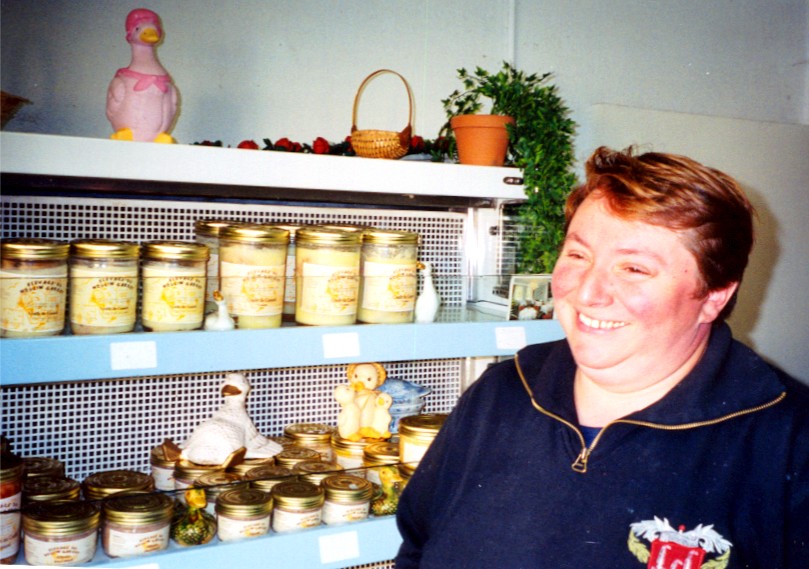 |
| Veronique in the boutique next to her home where she sells freshly-made
foie gras that contains no preservatives. |
As it turns out, one of the first and major foie gras producers in our
region lives only a twenty-minutes' walk from our house. Veronique Affray.
I've known her and her husband for years. In fact, we have a deal with
them whereby they give us a year's worth of foie gras and other things
in exchange for cutting and baling our hay for their cows. It's a convenient
way of keeping the fields around our place clean.Now this sounds like it would be the easiest interview in the world, doesn't
it? I know Veronique. And she lives right down the road.
It took me six months to do it. First, I was trying to finish a book and didn't
want to break my rhythm, to stop writing about war to write about foie gras.
Then after I finished the book, I ran into conflicts with Claude's schedule.
She went to Spain. Then to Portugal. Then back to Spain.
Finally, I said, "I'll talk to Veronique by myself. I don't need you.
I want to get this Letter done."
"You don't know anything about foie gras," Claude said. "You'll
need me."
"What do you mean? I've been eating foie gras for years. I can tell the
difference between the good and the mediocre."
"I don't mean that," she said. "You don't know the different
kinds and the precise steps of its production. You'll need me at least the first
time you talk to her."
"Then let's do it," I said. "This is taking far too long."
"Okay," she said. "Tomorrow morning before I leave for Paris."
Actually, the delay had a more subtle reason than just a conflict in schedules.
Although we didn't admit it, we were both reluctant to talk to Veronique. I
said that we've known her for years, which is true in a superficial sense but
not really in the sense of "knowing" someone. She and her husband
are always busy, a blur of action and hard work, and our exchanges had been
on the level of Bonjour, ça va?" "Oui, ça va. Et vous?" In
fact, like other people around here, we referred to them as Monsieur and Madame Canard.
Farmers often work by instinct and are passionate but not very articulate
in describing what they do. French farmers particularly speak in proverbs about
when to plant and when to harvest, based on the phases of the moon, the weather,
and other semi-superstitious things that generally prove accurate. We were under
the impression that Veronique and her husband had just started a foie gras business
as a subsidiary to their farm of cattle and sheep, and were sort of amateurs
who learned to do it.
How wrong we were!
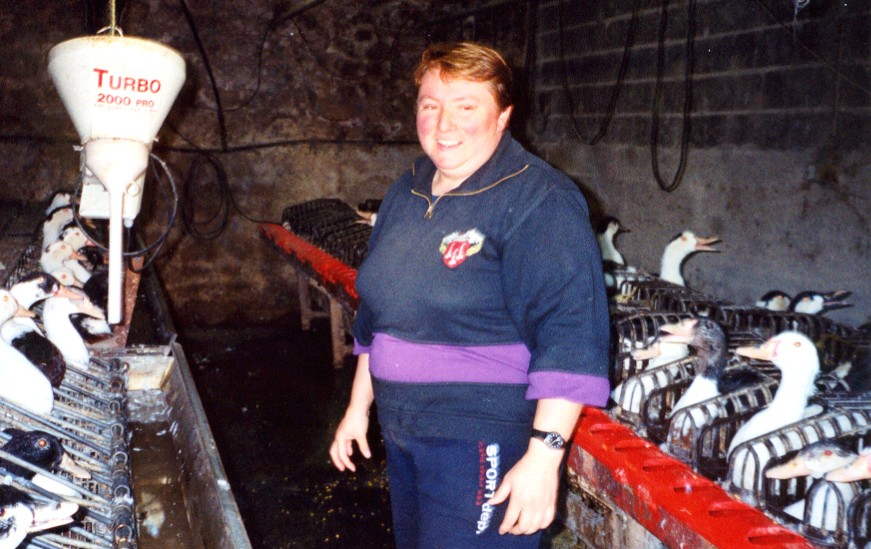
Veronique is preparing for the key step in the production of foie gras--the force-feeding of the ducks. |
Veronique's husband has nothing to do with the foie gras business. This
has been her deal from the beginning. And she's not an amateur who made
good but a trained professional.
Besides that, she is quite articulate and gives a vivid and detailed
description of how foie gras is produced.
It gets even better. Veronique has shown extraordinary courage and initiative
in establishing her business.
Veronique grew up in a nearby city. Her family had a metalwork business. As
a young girl, she wanted to be a career military officer or a farmer. Why? She
can't explain it. It was always one of the two. She decided on raising goats
and making cheese. She was taking a course but didn't much like it. A fellow
student was learning foie gras production, and Veronique got interested. She
signed up and took 200 hours of formal instruction, then spent a year as an
intern learning by experience. It was there that she met her future husband.
She was 21 when she finished her course. She heard about a farm on a small
river outside our village that was for sale. She got a loan from Crédit
Agricole France and bought the farm. She moved in and immediately started her
foie gras business.
This was high audacity for several reasons. A young girl, an outsider to boot,
taking over a farm by herself? And starting a foie gras business? It was unheard
of, this is the center of France. Foie gras is mostly produced in the southwest,
the Périgord, and the northeast, in Alsace. She was the first producer
in our region.
She soon won over the skeptics with her hard work and professionalism. People
started showing up at her farm, asking to buy from her directly. She also began
selling through shops, and eventually opened a boutique in a city with several
other women, specializing in farm products that are fresh and contain no preservatives.
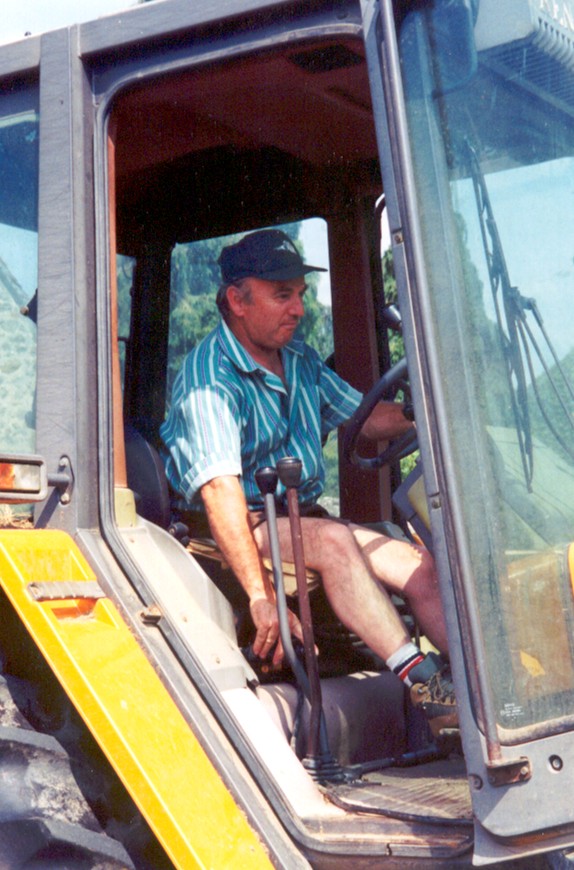
Veronique's husband, Aimé, in the saddle of his tractor,
where he spends much of his days. He's cutting our hay in August. |
Veronique orders 400 ducks a year. They used to cost $4 each, but because
artificial insemination techniques have been developed the cost has dropped
to $2.50, lowering the price of foie gras and making it more accessible
to the general public.
The one-day old ducklings come by mail. Veronique keeps them in a temperature-controlled
shelter for a month and a half. Then they are allowed outside but kept
separate from the older ducks.
At three and a half months the gavage--stuffing--of the duck to
create a fat liver begins. It lasts 18 days. Veronique uses moist corn.
She starts little by little, forcing the corn into the duck's stomach,
until she reaches the stage where she is feeding each one twice a day,
more than two pounds (a kilo) of corn. She hopes to produce a liver that
weighs at least a pound, or half kilo.
I was surprised by the amount of corn used in the daily stuffing, also by the
size of the liver. A pound? Gee, that's a big liver coming from a small duck.
The gavage of course is the controversial part of foie gras production.
That some people criticize the process doesn't seem to bother Veronique, this
is her business. She points out that a sick or unhealthy duck, or one not properly
cared for, won't produce the size and quality of the desired product no matter
how much it is stuffed.
I carried a vague misconception about foie gras production. I thought it was
done just for the liver. But while that is the most profitable part of the business,
the entire duck is processed and sold, including the magret, or breast,
which, in another act that might not find favor with some French purists, I
like to barbecue.
Claude and I never try to proselytize our tastes. People who oppose foie gras
or who are vegetarians are always welcome at our home. We always have plenty
of fresh vegetables and fruits, so there is never any problem whipping up an
alternative meal for anyone. But--hmmm--how we enjoy foie gras If you love it
too, drink a toast to us during the holidays.
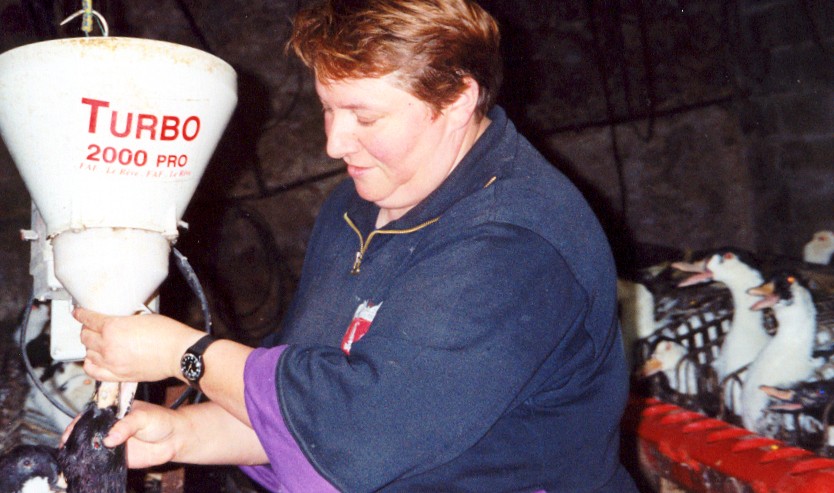
Veronique force feeds the ducks corn twice a day, reaching
two pounds a day over 18 days. This enlarges the liver. It is then cooked,
seasoned, and vacuum packed for sale. |
The Foie Gras Dissenter
Deborah Palmer is an art history professor at the American University of Paris
and a graduate of the Ecole du Louvre. She is one of our closest friends, an
American who has spent most of her life in Europe. Deborah is an animal rights
advocate, but she is against people who try to force their beliefs on others.
She believes that society is slowly evolving in the way it regards animals and
the kinds of food that should be eaten.
"If you live in the Arctic of course you need to wear fur," Deborah
says. "But why kill minks for a coat in Paris or New York?"
When she was a kid, Deborah had a goose named Amélie. She became uncomfortable
eating Amélie's compatriots and finally stopped. Then she subscribed
to an animal magazine, and read an article about foie gras which was a shocker.
It said the ducks lived in a permanent state of nausea. (I didn't observe any
reluctance of the ducks to undergo the gavage.)
"I don't run around telling people they shouldn't eat foie gras,"
Deborah says. "My mom cries about the process but still eats it. I quit."
When Deborah visits, I tell Claude, "Let her eat radish, with buttered
bread, the way the French like it. I'll take care of the foie gras"
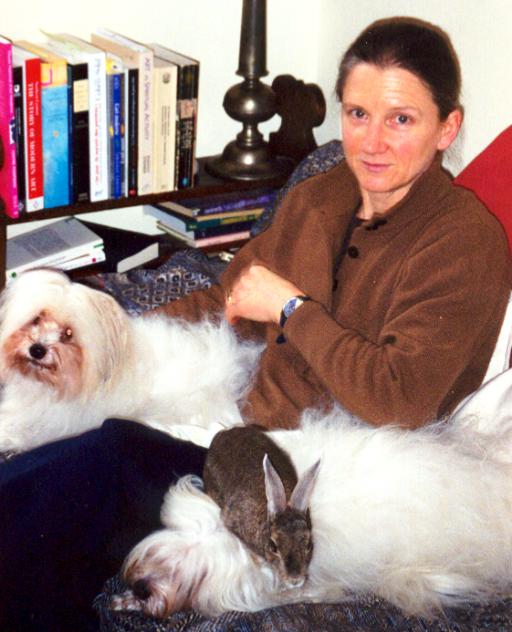 |
Deborah Palmer and her brood at her Paris apartment.
Prudence is a wild rabbit that Deborah found in a field and turned
into a pet. She is writing a book about the experience.
I've never heard of a wild rabbit being tamed and Deborah doesn't
use that word to describe her, but Prudence, now 14, is remarkably housebroken
and loves to play with the dogs.
I had a few pointed words for Prudence after she ate my telephone
wires, leaving me without a phone for a month. But I gave her a carrot
and we made up. |
Good Neighbors
Robert Frost is always quoted as saying "good fences make good neighbors,"
which is a distortion of the actual poem. I like Hesiod's quote much better:
"A bad neighbor is a misfortune, as much as a good one is a great blessing."
The holiday season reminds me that we have always had "great blessings."
From Spain to France, our neighbors have been some of the nicest people in the
world. The French stir a certain ambivalence in some American minds--and vice
versa in French minds. I have to admit, an American bureaucrat can sometimes
seem like the soul of compassion compared to his French equivalent. And the
attitude of Paris shopkeepers that the customer should say hello first and act
honored to give up his money is still a bit irritating.
But, really, we have always been surrounded by neighbors of warmth and generosity
and integrity. And I'd like to honor a couple of them during this season.
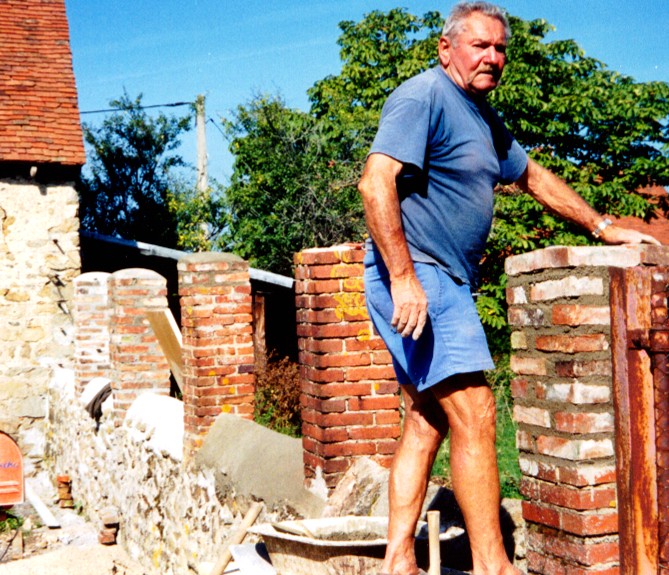
Monsieur Lucien Pierre and his wife Suzanne are our closest
neighbors in every way. They have been married 53 years, and were childhood
sweethearts.We could walk out of our front
door on five minutes notice and not return for a month, and we wouldn't
have the slightest worry about our house or our animals. They would take
care of everything. The trust between us is absolute.
Here Monsieur Pierre is rebuilding our barnyard fence,
which he volunteered to do, as he does so many things.. |
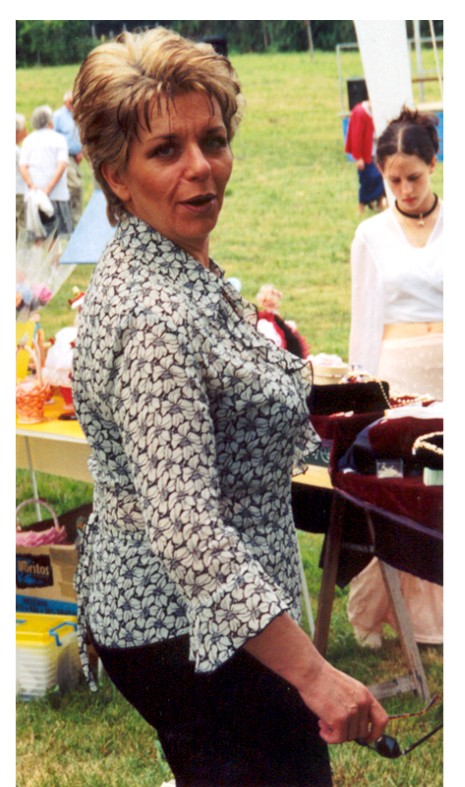
Chantal and her husband Gilles and son Maxime live around
the corner from us. I was overjoyed to learn
she is a coiffeuse domestique--a hair stylist who
makes house calls. No more waiting an hour or
two in the
village barber shop, listening to guys
talk about prostate problems, hunting,
and who
drinks too much. Chantal is the only haircutter
I've ever known
who actually does what you ask
her to do. Her good-neighbor price is not bad
either--$14 to do my hair and beard. |
|
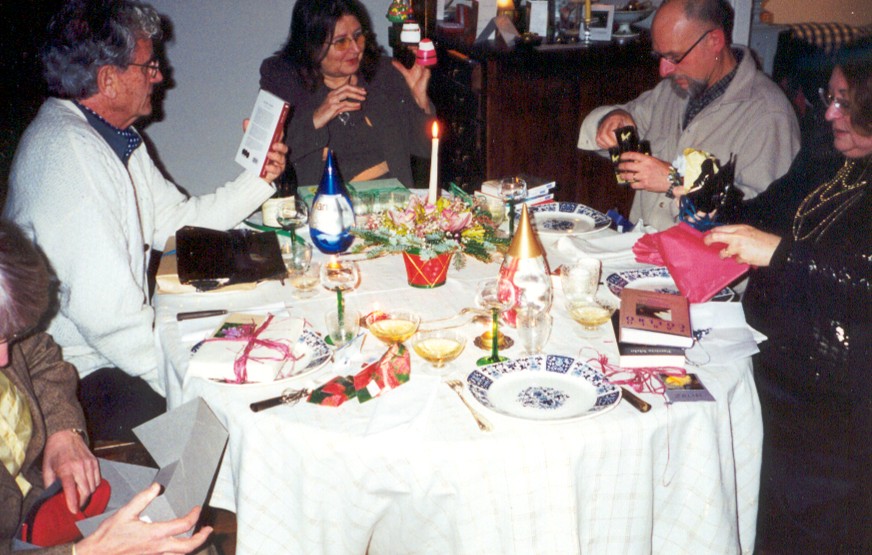
This was taken at our home on New Year's Day. Between Christmas and
today I had
eaten 10 dozen oysters. We are going to start with foie gras for lunch.
|
|